Sansevier: description, types and cultivation
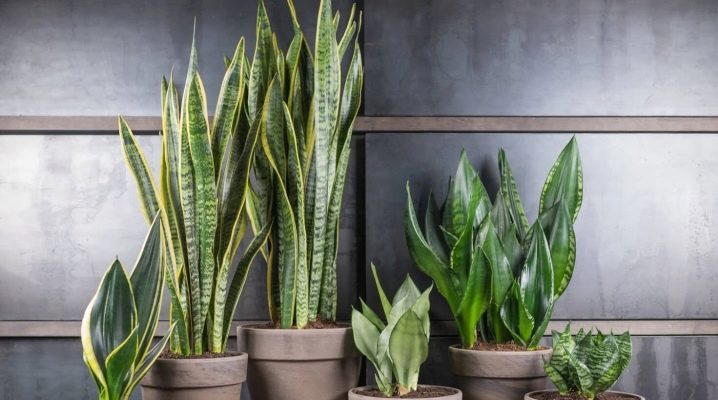
Sansevier has quite a few names, the most popular type looks like tongues of flame, striving upward, only green. The plant is grown with equal success at home and outdoors, there are certain rules for reproduction, planting and care.
Peculiarities
Sansevier, better known as "Mother-in-law's tongue", is also called "Pike Tail" - a popular indoor flower. It may look different depending on the type. Designers actively use its attractive and unusual appearance in the interior of the apartment.
Country of origin Africa, Madagascar island and South Asia. It is a hardy plant with leaves that can reach a height of several tens of centimeters.

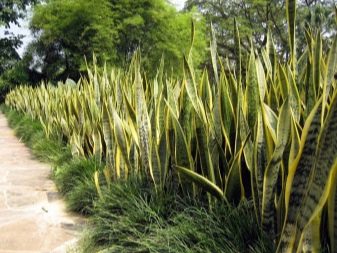
Sansevier has flowers, but they are tiny, so the plant is loved more for its rich green foliage. Inflorescences are collected in small bunches on long stems or racemes, berries appear later. In their native habitat, flowers are pollinated by moths.
Grown indoors, they do not produce seeds as there are no natural pollinators.
Sansevier can be grown from seed, but more often it propagates through underground rhizomes. Stunted species do not produce many shoots, while others are very aggressive and can become invasive in the landscape if grown in a tropical area.
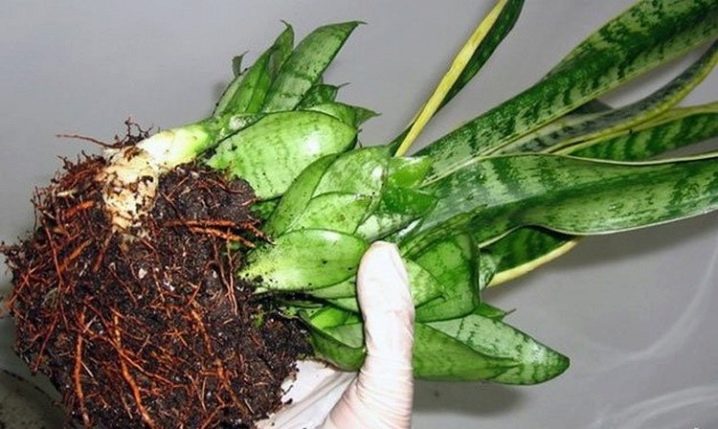
Some species may have a white border or yellow-striped leaves and tiny light green fragrant flowers. It is a stemless perennial plant. It can bloom in summer or autumn, but very rarely at home. Many species have tough fibrous foliage, which is sometimes used to make ropes and bowstrings.
Wide leaves need to be wiped regularly so that the plant can "breathe"... It is one of the very best air purifiers and removes toxins such as formaldehyde, xylene and toluene from it.
This plant is poisonous, therefore, when it enters the gastrointestinal tract, it causes such unpleasant symptoms as vomiting, diarrhea, and nausea. This applies not only to people, but also to animals, which often try to gnaw the leaves, therefore it is advised to keep the flower away from the floor, out of the reach of children and pets.

Views
Sansevieria is about 70 species and only 2 of them are grown at home. Among the rest, several options are most common.
- "White"... A variety that was selected in 1948. Of the distinctive characteristics, the presence of white longitudinal stripes on the foliage, which alternate with dark green ones, can be distinguished. This plant grows very slowly, the leaves are tough and straight.
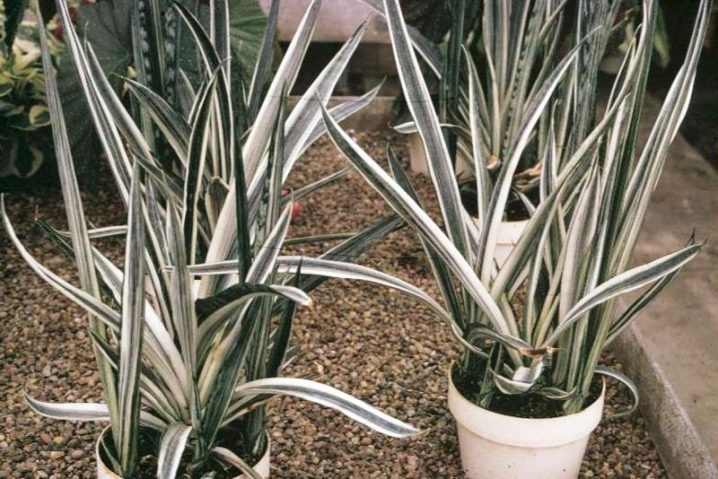
- "Cylindrical"... It grows up to two meters in height. The foliage is dark green, there is a dense groove in the middle. A thorn forms at the top due to drying of the leaf.
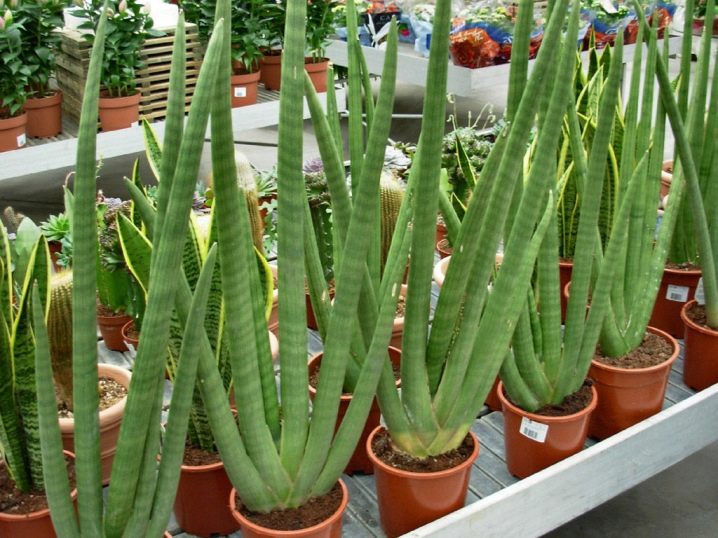
- Hanni... Demonstrates small bent leaves, looks very much like a vase from the side. There is a subspecies "Golden Hanni", which has yellow stripes.
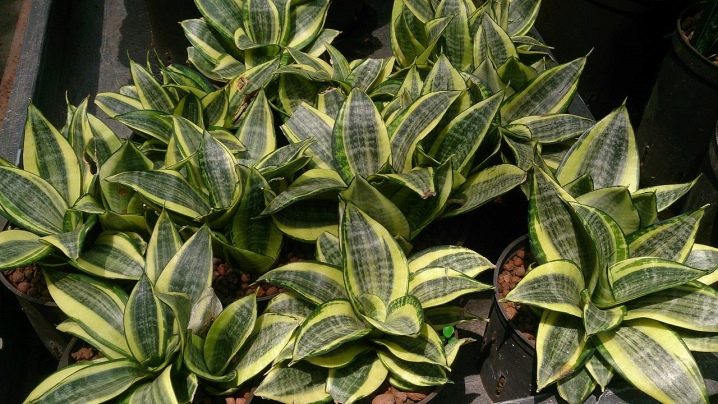
- Silver Hanni - resembles the previous variety in shape, but the foliage is light, very attractive silvery shade with a dark edging.
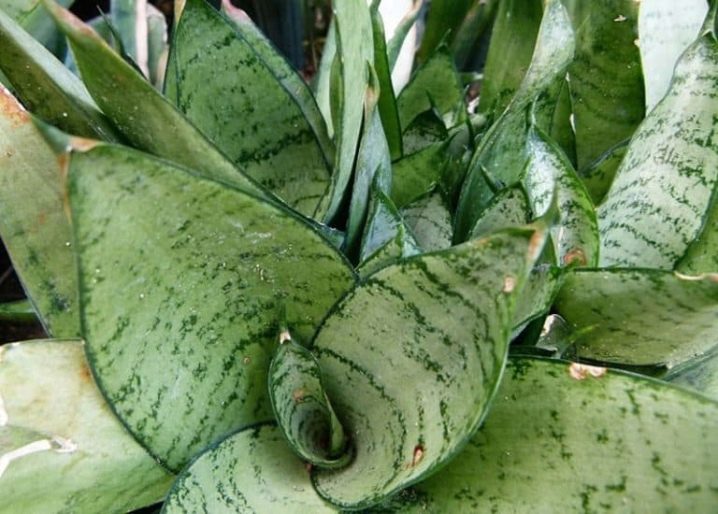
- Laurenti... The leaves are long, have transverse light stripes and a yellow border. This species is often the basis for the development of new varieties.

- "Futura"... It differs from the Laurenti variety both in small in length and in wide leaves, the strip with a yellow tint in this plant is thinner.
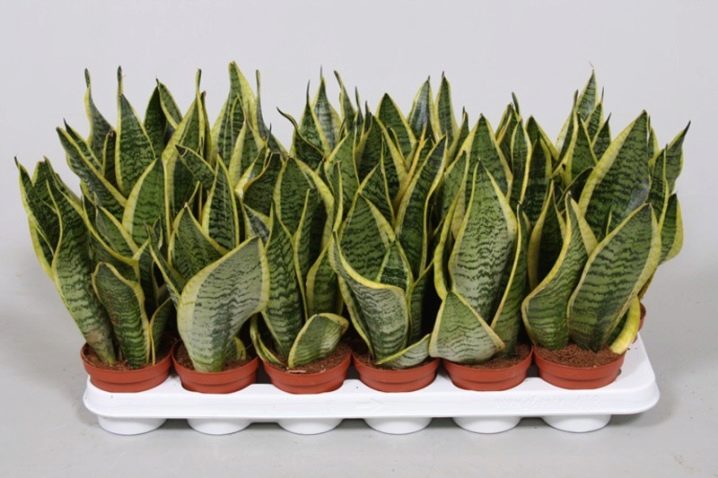
- "Robusta"... It has no stripes, but has an interesting shape. The subspecies has very dark leaves, no pattern.
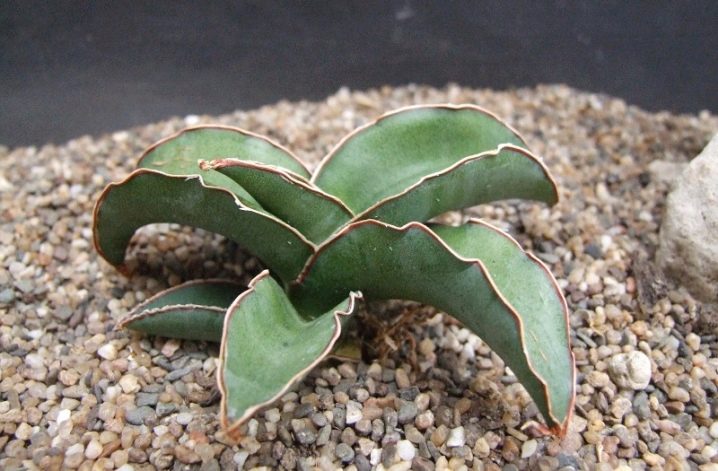
- "Moonshine"... Newly developed variety with gray-green leaves that repeat the shape of the Futura.
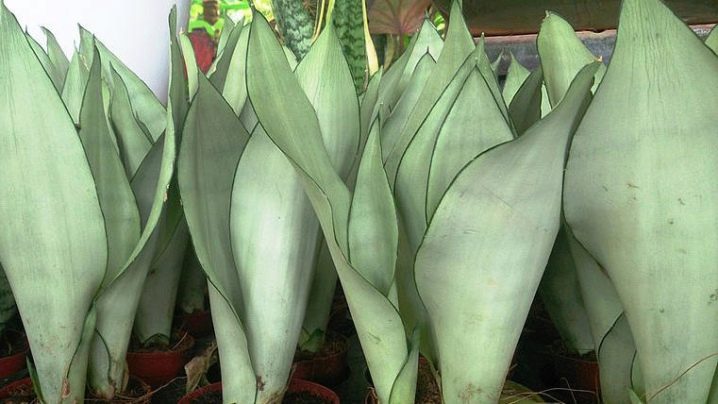
- "Nelson"... The peculiarity of this subspecies is the presence of a velvety sheen on the leaves, which are directed upwards. The bush grows short but dense. It is better to propagate with rhizome in order to maintain properties.

- "Silver Queen"... Demonstrates silvery-silvery foliage with a small thin border in young plants.
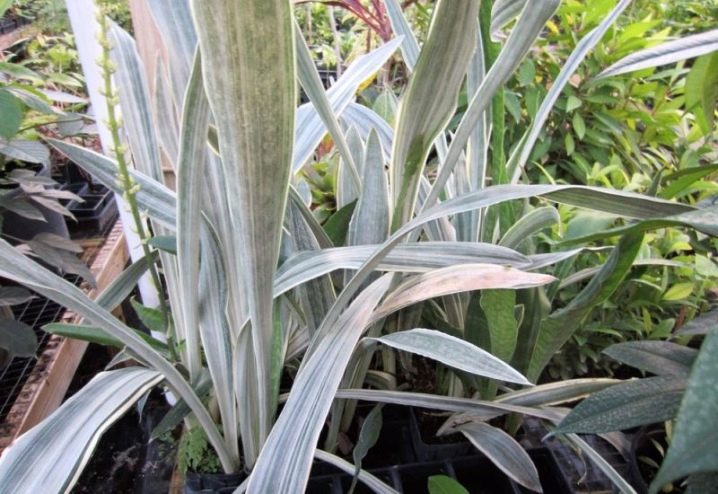
- "Compact"... Looks like Laurenti from the side, but there is a slight curl at the tips.
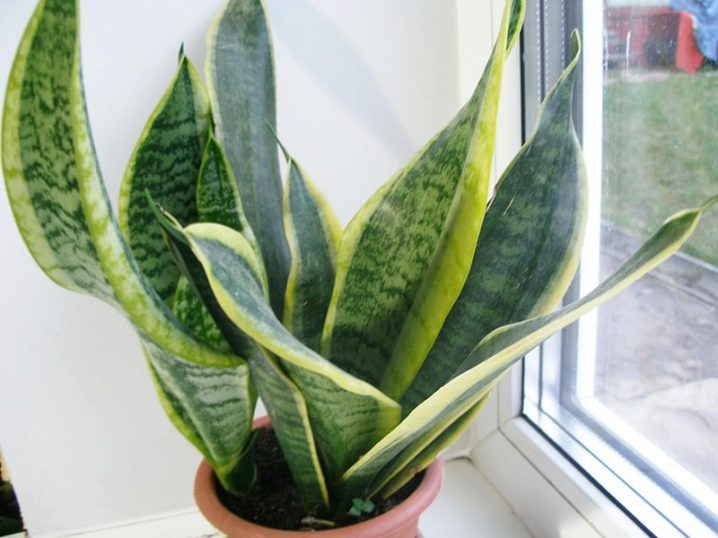
- "Velveteen"... The plant has an unusual shape, since the greens are twisted into small tubes. The upper part dries out over the years.
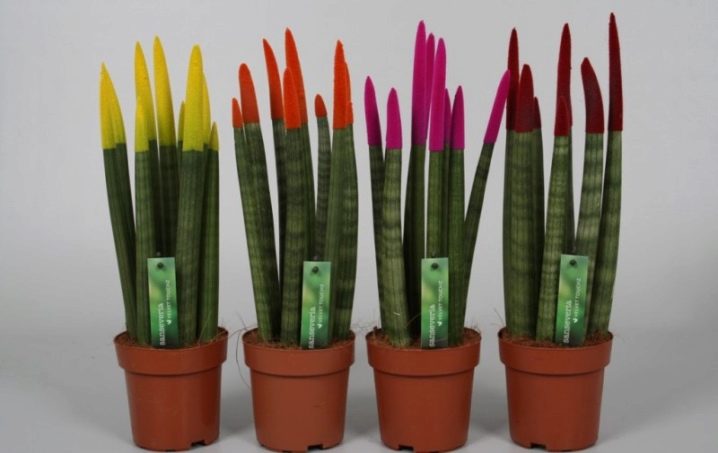
- "Bakularis"... It has cylindrical leaves that are very dense and sinewy. Does not like a large amount of moisture, the bush begins to rot.
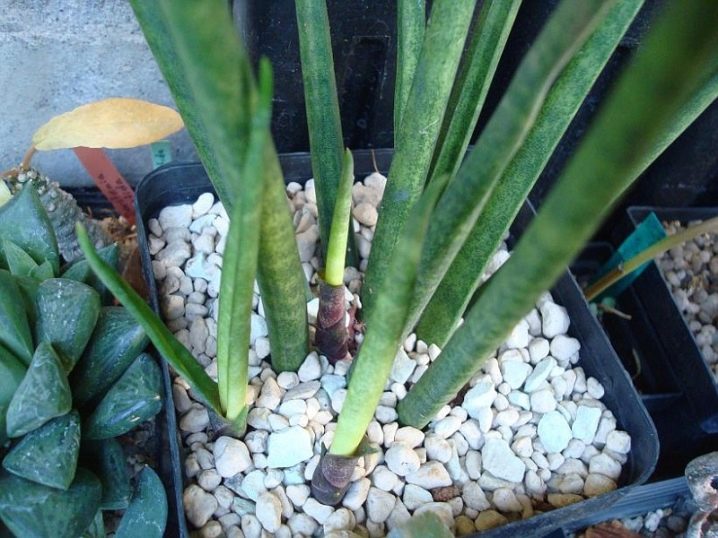
- "Black Gold"... The classic version with dark foliage, completely unpretentious to growing conditions. It has a light border at the edges, the leaves are straight.

- "Hyacinth"... The bush is formed from 10-15 leaves, on the surface of which there are transverse stripes of emerald color.
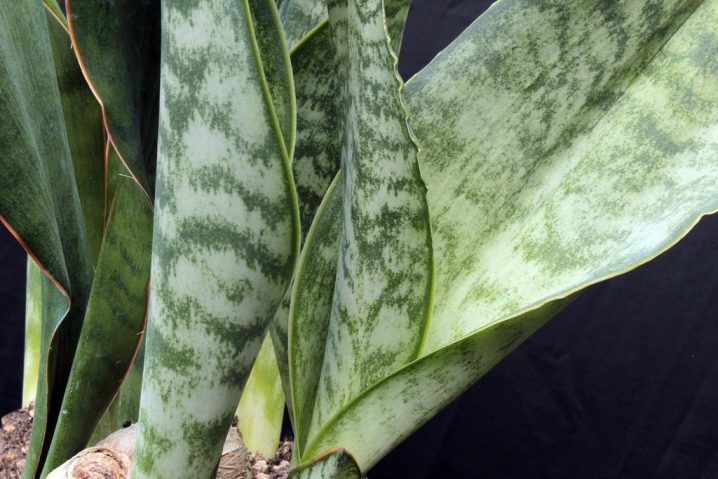
- "Ayo"... It blooms in winter in small inflorescences that have an exquisite aroma. Leaves are short, collected in rosettes of 5 pieces.
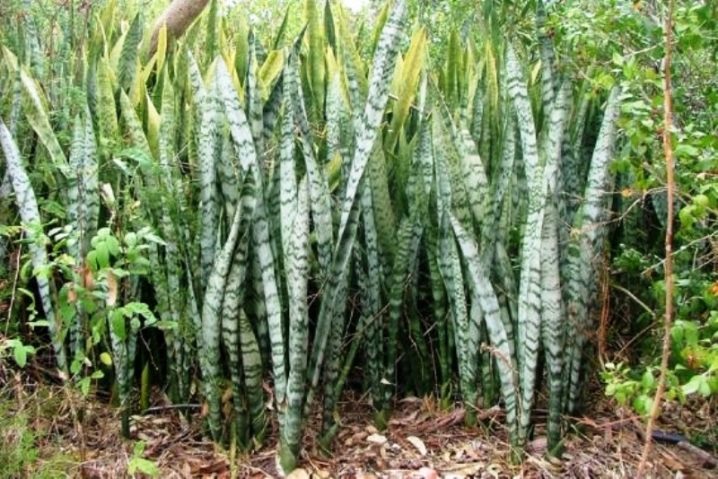
- "Three-lane"... The plant does not have a stem, all shoots are attached to the rhizome. The plates can reach heights of up to one meter, although there are also dwarf subspecies. The flowers are very inconspicuous, but have a strong aroma.
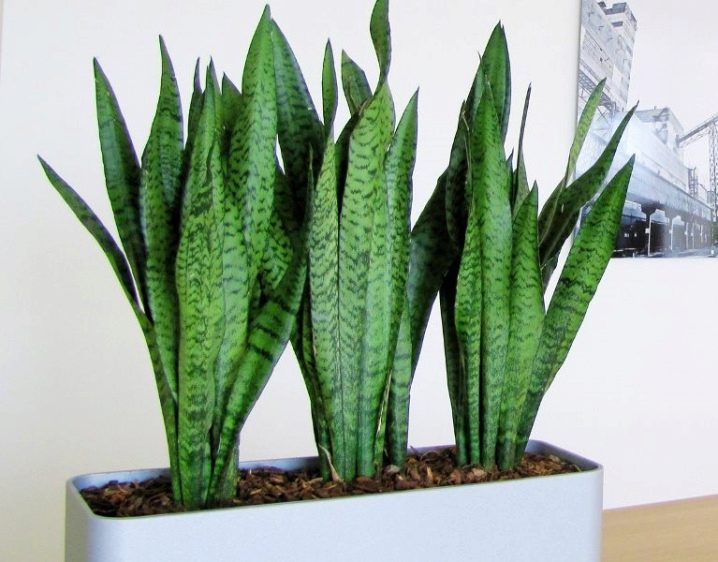
Landing
Sansevier can be grown not only indoors, but also outdoors, since it is very resistant to low temperatures. The main thing that is required from a grower is good drainage, since this species does not like a large amount of moisture.
If you water a sansevier or plant it in a humid environment, it will soon rot and die.
The ability to withstand drought well has made the plant popular in arid regions as a major landscape decoration.
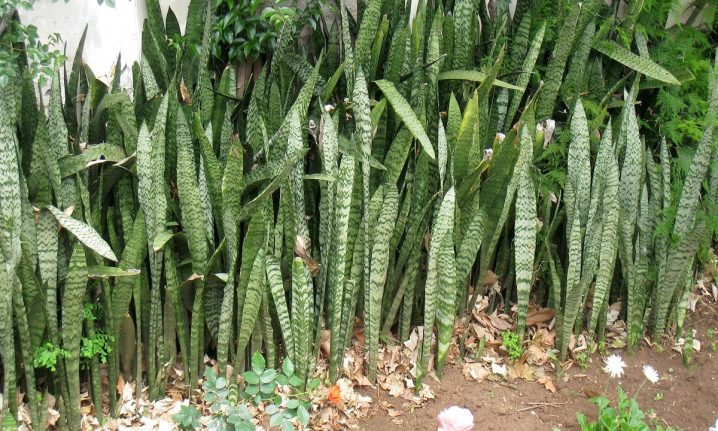
Sansevier prefers plenty of sun, but will thrive in light to moderate shade.... However, some species with colored coloring may not show it unless you give enough sun, meaning the leaves will remain just green without any golden edging. What's more, too little light will result in poor growth and small bushes.
Over time, if the breeder has chosen the right planting site, the plant begins to fill everything around him. In this case, there are three ways to deal with the problem:
- you can dig up shoots every 2-3 years;
- it is necessary to plant the sansevier in containers, which are then placed in the ground, so that they remain out of sight, keeping the growth;
- they set up barriers several tens of centimeters into the ground, which prevent root overgrowth.
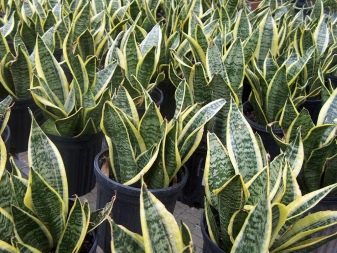
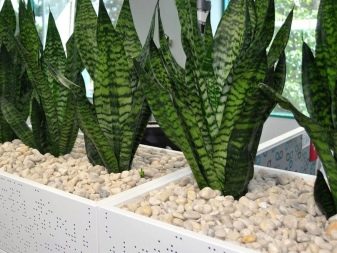
Planting time in the soil - early spring... This flower does not have any special requirements regarding the quality and fertility of the soil, so it does not require much attention to itself. A small depression is made in the ground, into which a bush is placed, so as to cover the root collar with soil. The first watering is carried out, then the soil around is moistened no more than once a week and slightly.
If rainfall occurs regularly, then there is no need to water.
Most hobbyists and professionals alike grow Sansevier as a houseplant. It adapts perfectly to indoor life. It is best to place the pot in a sunny place., but even a room with a little light is suitable.
For planting, you can use cactus potting soil or add coarse sand to regular sand to provide the quality drainage these plants need.
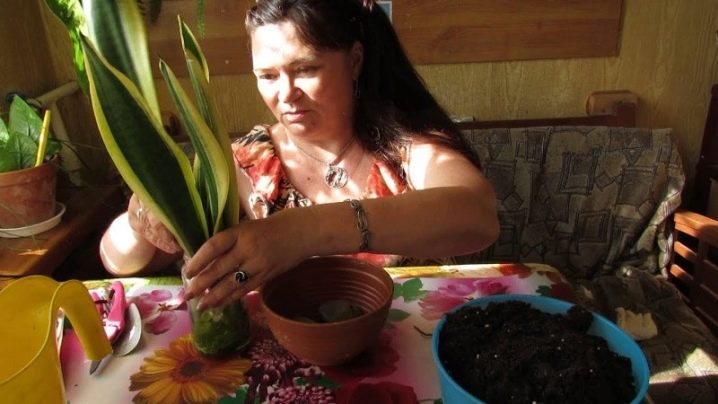
The soil is allowed to dry out a little between waterings.The ideal sansevier container is made of clay because the material is porous, which makes the soil dry out faster than plastic.
Some plant species grow rapidly, so division will need to be done annually. For planting, you should use a shallow but wide container... The bushes have a shallow root system, but it grows well. The soil at the bottom of a deeper container retains moisture longer, and it leads to root rot.
The transplant is carried out in the spring, at the same time, you can fertilize the plant with a balanced composition (10-10-10 or 8-8-8). The second time feeding is applied towards the end of the growing season, that is, in August. The plant should not be fertilized in winter.
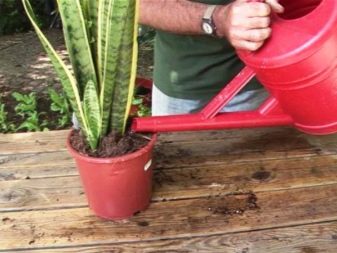
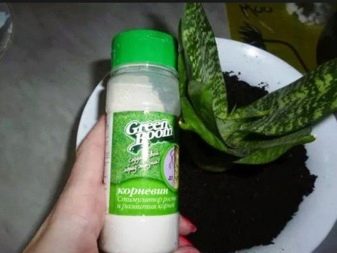
Home care
If the plant is grown or transplanted at home, then it is worth putting it in a place where there is moderately bright or diffused light for as long as possible. The position in front of the north window can be considered good.... Although the plant tolerates the absence of light well, it helps to reveal the color on the leaves.
Too much direct sunlight can cause the edges of the leaves to turn yellow.
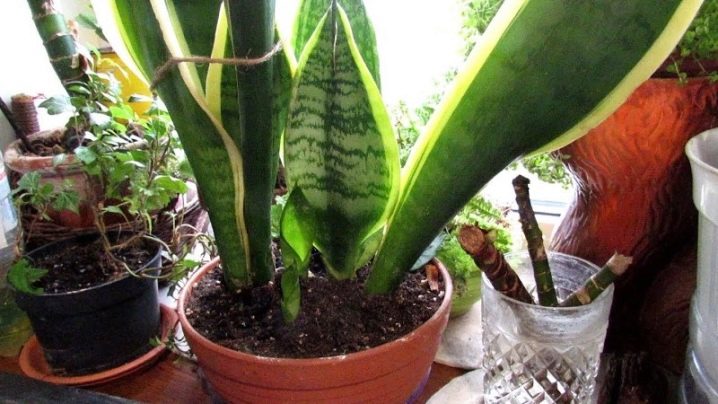
Be sure to let the soil dry completely before watering.and then wet well until water flows through the drain holes. The pot must drain before placing it on the saucer. The soil should not be allowed to remain damp for a long time, watering is reduced to a minimum in winter.
Like most succulent plants, it stores water in its leaves, so the sansevier rots quickly in overly moist soil.
The flower is prized for its interesting appearance. Although the most common variety is known as "Mother-in-law's tongue", other equally attractive species can be found on windows. Other varieties grow into compact rosettes and reach a height of up to 10 cm. Even with minimal care, this plant lives and pleases for many years, and sometimes it seems almost invulnerable. Sansevier is suitable for outdoor planting.
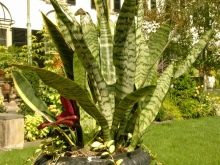
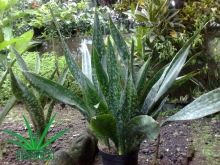
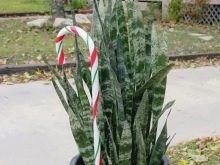
It is best to transplant the flower and feed it once every 3 weeks throughout the summer. Too much fertilizer causes the leaves to fall off... When the plant has flowering, it is worth looking after more carefully, watering on time and wiping off the dust with a soft damp cloth. If any shoots are damaged or spoiled, they are cut off from the root. To plant a flower means to act very carefully so as not to damage the roots.
Several types of weeds are also serious pests in the field of flower cultivation. Leaves need enough light, so no higher plants should grow around. This also applies to grass. Research has shown that herbicides are quite effective in combating this problem, but they can also harm the sansevier.
When grown in a greenhouse, it is required to regularly weed the territory in a flower bed.
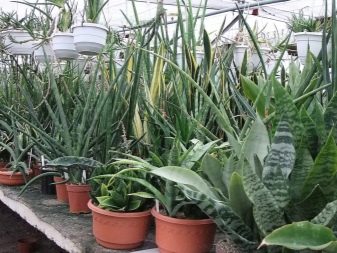
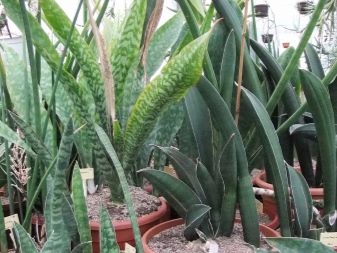
Diseases and pests
The appearance of pests and diseases is often unpredictable. Suddenly, the leaves become torn, exposed to insect bites. Outdoors, this is usually a snail, which is very fond of sansevier. The activity of this creature wakes up at night, if the situation is such, then the beauty of the plant becomes no longer visible. Most pests are visible to the naked eye, others can only be seen with a magnifying glass.
The main pests that attack the flower are mealy and spider mites. They feed on the plant by sucking the sap from the leaves. This, in turn, causes wilting and possible shrinkage if the problem is not eliminated in time. They also harm the sansevier, making it more susceptible to disease and other pests.
If you treat the foliage with alcohol, the mites will disappear. High humidity also helps, but this process must be carefully controlled, since you can harm the flower.
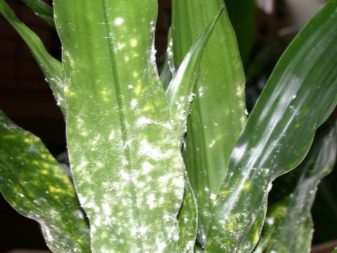
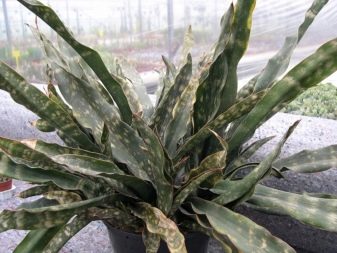
It is easier to eliminate pests than diseases.Plant breeders use several methods of dealing with both. The first is mechanical or manual, the second is with the use of chemical and biological means of protection. Each method has its own advantages and disadvantages. Depending on the size of the planting, they have a certain level of efficiency.
Diseases that affect sansevier are usually sporadic, but difficult to overcome. The damage is done quickly and strongly. Pathogenic organisms are not only a fungus, but also bacteria and viruses. These organisms usually cooperate with others called vectors. For prophylaxis, a fungicide or bactericide is needed before planting seeds.

The best way for plant lovers to avoid pests is by using appropriate sterile planting material. Regular spraying with pesticides is very effective in eradicating pests.
Sansevier is mainly affected by fungal diseases, which, in turn, arise from the presence of moisture on the leaves. Reddish-brown punctate lesions appear on the leaves. White spider webs may be visible, which later turn brown and harden. The grower must take preventive measures: the leaves must remain dry, proper watering, good drainage.
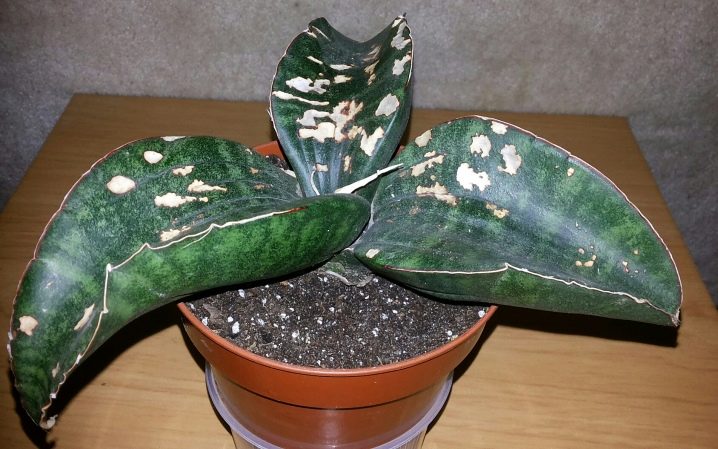
Bloated, smelly leaves - the result of too much watering or waterlogging... Excess water causes plant cells to burst inside the leaves, causing bloating and odor. It is required to remove the affected shoots and normalize the watering plan.
Brown leaves are a sign that the plant, on the contrary, lacks moisture.... Brown tips may indicate inconsistent watering. Do not remove them, as this leads to scarring of the plant. Instead, it's best to stick to your watering schedule and let the flower heal on its own.
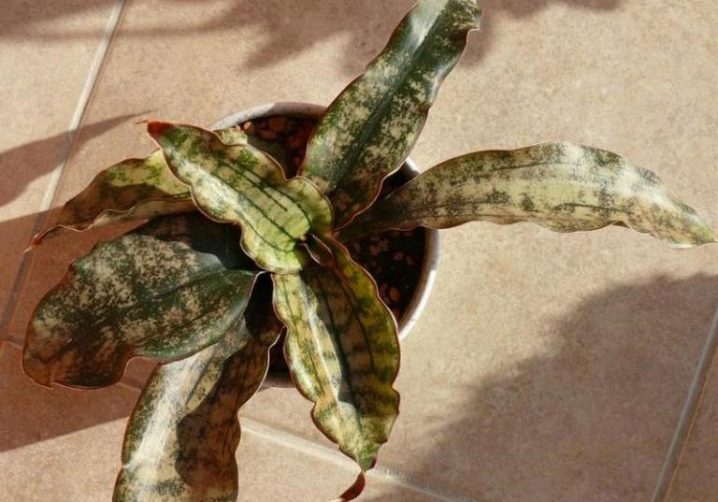
Scarring is caused by too frequent contact with the foliage of children and animals. In this case, scarring will be inevitable, in addition, any rough handling causes the appearance of a scar.
Rot at the base - usually appears in the winter from watering too often... No treatment in this case will help, if all the leaves have signs of rot, then the plant cannot be saved, but you can try to cut off the cuttings and propagate the flower again.
Red spot spreads to new leaves of bushes that are in the center... Infection appears and spreads when it is humid, since this is the environment most conducive to spores. Lesions are uneven, reddish-brown in color, with yellow edging. In conditions of high morbidity, the infection spreads very quickly. If the bush is treated with a fungicide, growth in the center can resume, often from several buds.
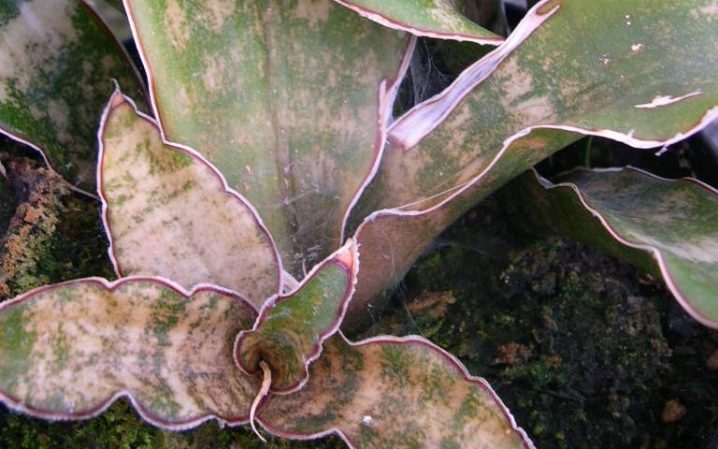
Disease prevention comes down to keeping the foliage dry. If this is not possible, it is worth using one of the available fungicides to reduce symptoms.
Southern late blight - a pathogen that attacks the entire plant, without exception, but most often can be seen on foliage. The first symptoms similar to necrotic lesions near the ground line... The white mycelium is dense, fan-shaped and can be seen on the ground or leaves.
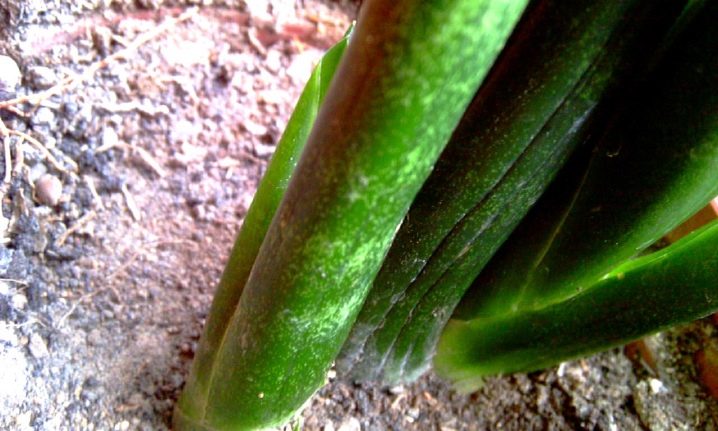
The affected areas have a round shape and are initially white the size of a mustard seed. Then they acquire a dark brown color and harden. Mycelium and sclerotia grow simultaneously with rot and wilting of the stem.
Root nematode - always visible at the root... Stunted growth and wilting of the plant accompany the problem during the developmental phase of severe infestation. As a means of prevention, it is worth using sterile soil.
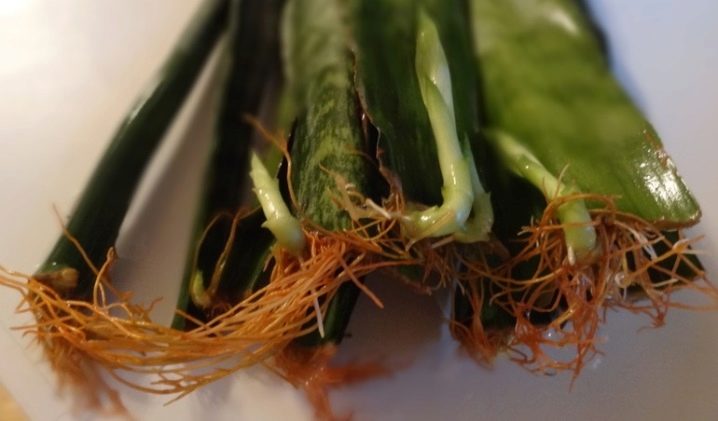
The main arthropod pests of this plant species include moths (worms) and thrips.
Caterpillar infestation is easy to detect, because worms and their excrement are usually clearly visible with the naked eye.The damage appears as holes in the center or at the edges of the leaves. Often confused with snail damage.
The only way to determine which pest is involved is to find a sample.
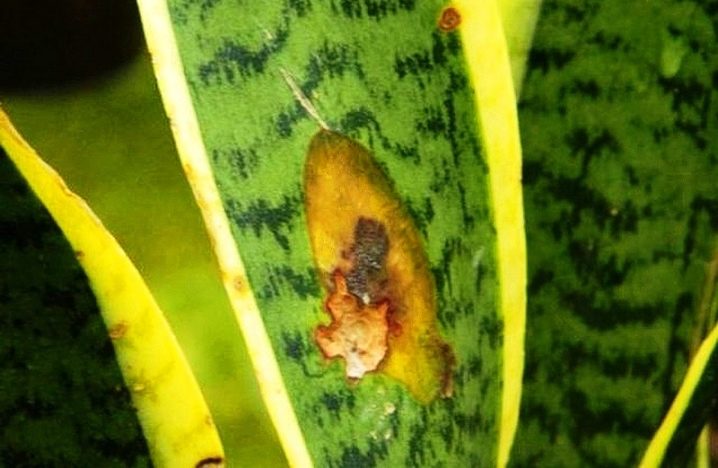
Thrips are small insects and can be identified as adults by the long fringe around both pairs of wings. Infected leaves become curled or distorted, with silvery-gray lines or calloused areas. Thrips can additionally transmit a virus that infects ornamental plants.
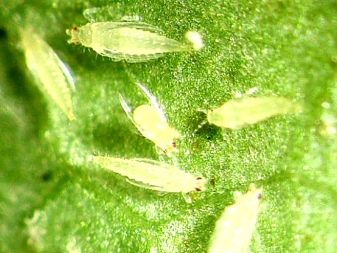
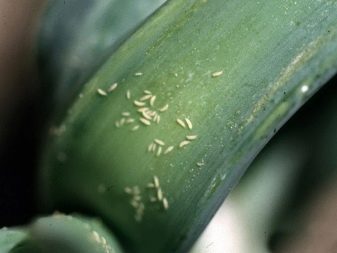
Reproduction
Sansevier is very easy to propagate, for this they use 3 methods:
- root shoots;
- seeds;
- leaves.
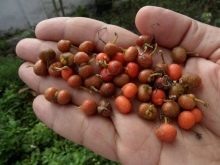

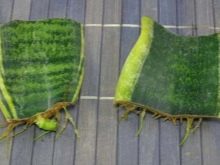
A new flower is formed from the rhizome, which eventually spreads strongly over the immediate area. And you can also grow it from seeds, if you can find them, since flowers do not produce berries at home, since there is no pollinator. Despite the fact that this plant grows in the subtropics and tropics, it feels great in our country.
For planting, you will need an organic mixture as soil, a place with enough light, and timely watering.
Reproduction is best done in the spring, but summer and autumn are not bad periods for this. Although the sansevier produces seeds, it usually propagates in our country by the root. To make a division, you will have to remove the entire plant from the pot. The two parts are separated from each other, it is worth acting very carefully, since the leaves may have already intertwined with each other. You may need to use a sharp knife or garden shears to cut the rhizome.
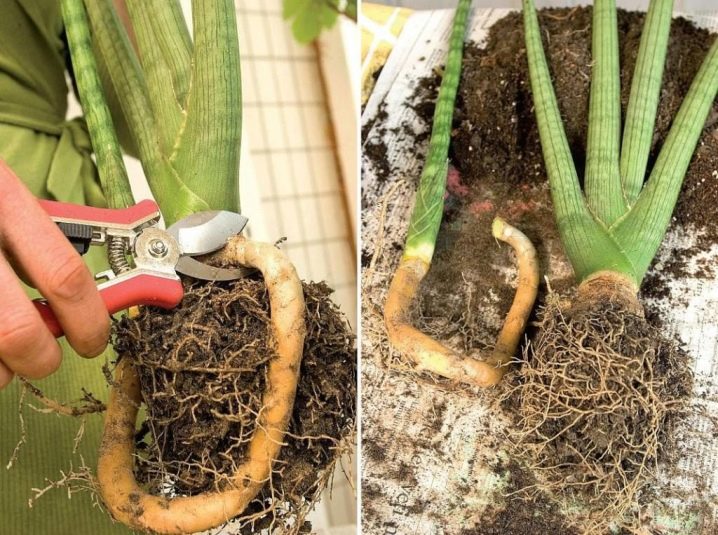
Leaf propagation is not the preferred method, but it is worth mentioning. Growers do not like it because it is quite complex, time-consuming and not always successful. The knife for work must be clean and sharp. When the leaf is cut it is allowed to dry for a few days before being placed in a pot with soil and good drainage of the potting mix. Such a cutting takes several months to germinate, so you should not expect quick results. This method of propagation is more often used when the plant has completely died from rot, when the root system becomes unusable.
Almost no one in our country propagates this plant with seeds, since it is very difficult to get them.
You will learn how to care for a sansevier in the next video.


























The comment was sent successfully.